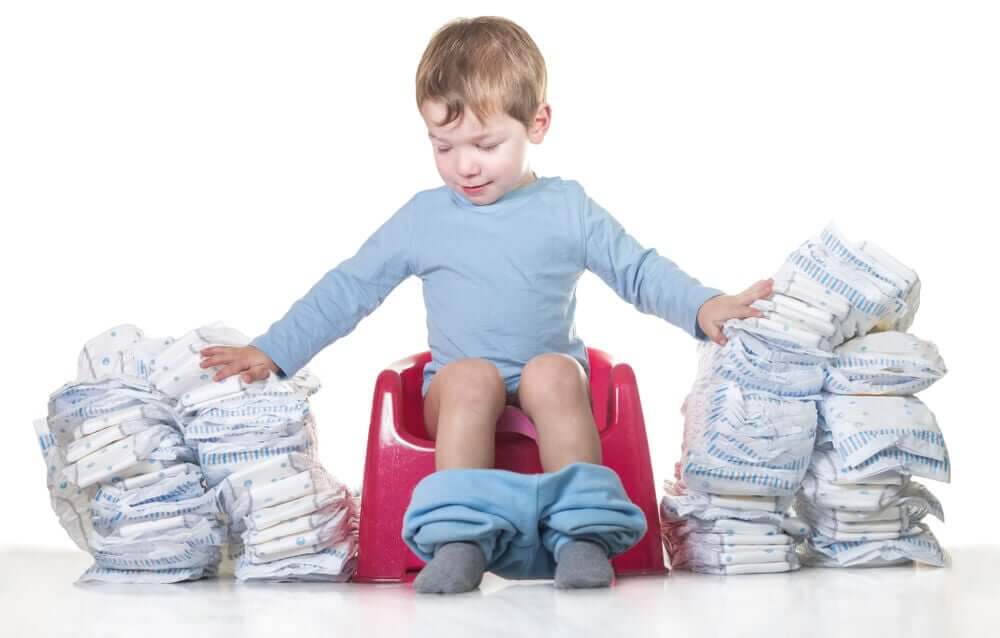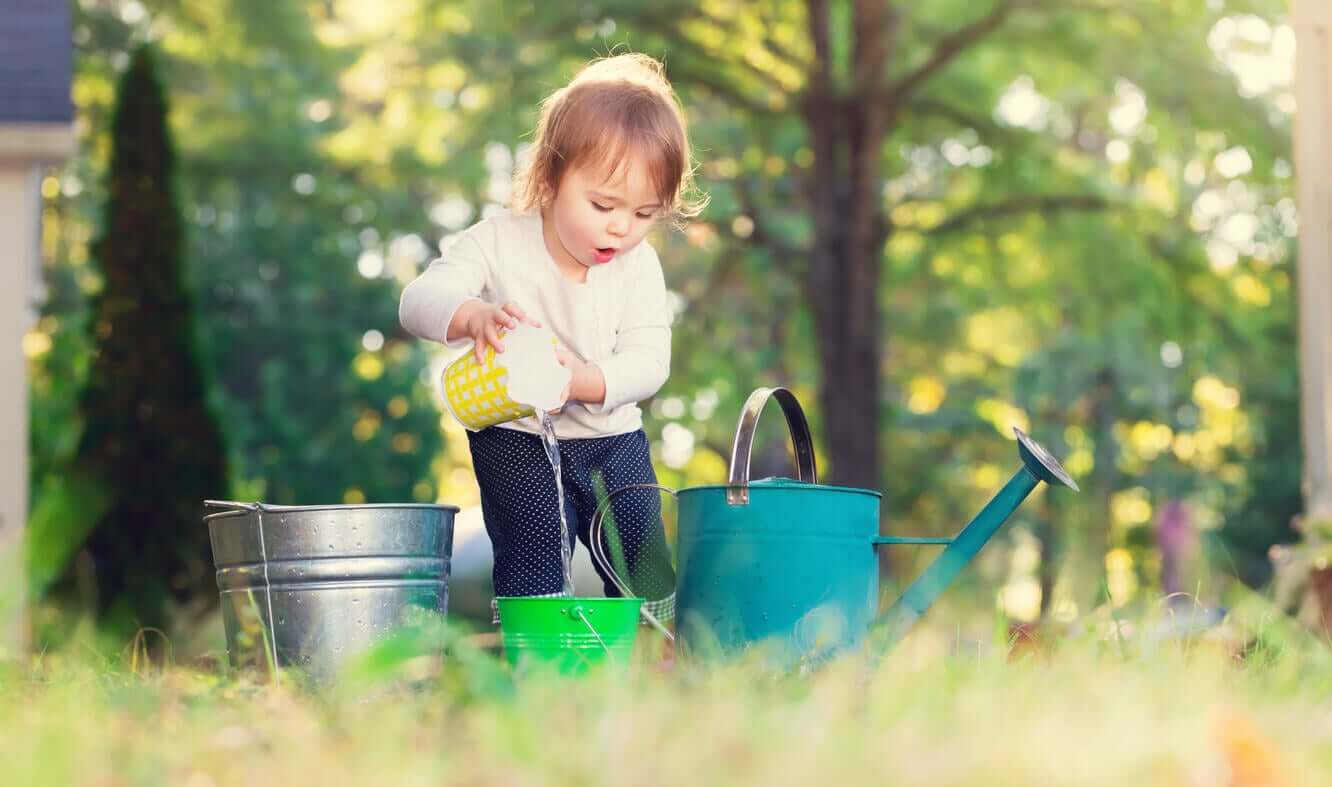The Fellom Method for Toilet Training Your Child in 3 Days


Written and verified by the psychologist Mara Amor López
Have you heard of the Fellom method for toilet training children in just 3 days? It’s a technique that many parents have used to help their little ones to achieve this milestone. Those who have tried it say that it is a very effective way to teach children to stop needing diapers in just three days.
For children, toilet training is a challenge and for parents, an exercise in patience and dedication. It’s not always easy, and success depends on many factors. Sometimes, the issue can be prolonged and ends up making children and parents despair.
Are you interested in learning about the Fellom method so your child can potty train? Go ahead and keep reading.
What is the Fellom method to toilet train children in just 3 days?
This technique is named after Julie Fellom, a preschool teacher from San Francisco, who came up with a way to reduce the number of disposable diapers in landfills. After verifying its effectiveness, she later decided to help parents train their children to stop using diapers.
The best time to apply the Fellom method is spring or summer, as all clothing below the waist must be removed from the child. That is, leave them without a diaper and without underwear or pants.
Next, we’ll share the essential instructions you’ll need to follow in order to put this technique into practice:
- A month before starting to apply the method, you have to discuss the issue with the child and make sure that they accompany you to the bathroom to see how the potty or toilet is used.
- A week before, you must explain that there will be no more diapers, and this can be presented as a game. You can even make up a story to make it easier for them to understand.
- For three days, the child has to be naked from the waist down all day.
- In each room of your house, you should place a potty.
- During these three days, you have to try to get the child to drink more water or to eat foods with a high liquid content so that they have a greater desire to pee.
- Have a mop handy, as you’ll need it.
- When you go out, your little one must be dressed but without a diaper or underwear. In addition, you must carry a backpack with a change of clothes and a potty.
- At night, your child can wear a diaper, but not a very absorbent one.

How to start potty training your child with the Fellom method
The process lasts three days, and to carry it out, you must take into account the following steps.
Day 1
Prepare them a breakfast that includes more liquids than on other occasions, because the idea is for them to have a greater desire to pee.
Observe your child carefully and as soon as you see that they want to urinate, take him to the closest potty. There may be a few accidents at first, but this is part of learning. Don’t scold your child and let them help you clean up.
When you go to the toilet, it’s very beneficial for your child to accompany you so you can teach him how to pee. Don’t forget that parents are their greatest example.
During these three days, patience and dedication have to be your greatest allies. Every 15 minutes, take your child to the potty to sit down. In the case of boys, it’s also better to have them sit down rather than try to learn to urinate standing up right away.
Before going to bed, be it naptime or at night, you have to sit your child down so that they try to pee. Don’t forget to reinforce each of their accomplishments and celebrate when they pee on the potty.
Day 2
This day will be the same as the previous one, except that you can go out with your child. How will you go about it? Well, you have to take the opportunity to go out when your child has already peed in their potty. You must dress him, but without underwear or a diaper, and don’t forget to put a change of clothes and a potty in a backpack. If they tell you they need to pee, use the potty you’re carrying.
Day 3
The instructions are the same as the two previous days, but this day, you can go out with your child twice: In the morning and in the afternoon. In both moments, as in the previous day, take the opportunity to go out when they’ve just finished peeing. Bring along their backpack with their clothes and a potty again.
How can you tell if your child is ready to stop using diapers?
You may try this method, but it may not work for you. If that’s the case, don’t get upset! Each child is different and each one has their own rhythm and their own maturation process. If the Fellom method doesn’t work for you, it’s better not to force things and wait longer to take this step.
Below, we’re going to share with you some of the signs that may indicate that your little one is ready to stop using diapers:
- The child warns you when they pee.
- You notice that they’re uncomfortable when they have a wet diaper.
- Sometimes they take off their own diaper when it’s wet.
- They only wet their diaper every 3 to 4 hours and when they do, they urinate a large amount. That means their bladder muscles are ready to hold their pee for longer.
- They’re interested in going to the toilet and watching you go to the bathroom.
- You feel that they’re more independent and that they like to achieve new achievements.

About the Fellom method
Now you know what the Fellom method consists of and how it can help you get your child out of diapers. Still, remember that this technique requires a lot of dedication, patience, and perseverance.
Don’t worry if the first time you implement it your child isn’t able to fully potty train because each child has a different learning time and maturation rate.
Don’t forget to motivate them and accompany them during these three days to help them to leave the use the potty without problems. Are you ready to give it a try?
Have you heard of the Fellom method for toilet training children in just 3 days? It’s a technique that many parents have used to help their little ones to achieve this milestone. Those who have tried it say that it is a very effective way to teach children to stop needing diapers in just three days.
For children, toilet training is a challenge and for parents, an exercise in patience and dedication. It’s not always easy, and success depends on many factors. Sometimes, the issue can be prolonged and ends up making children and parents despair.
Are you interested in learning about the Fellom method so your child can potty train? Go ahead and keep reading.
What is the Fellom method to toilet train children in just 3 days?
This technique is named after Julie Fellom, a preschool teacher from San Francisco, who came up with a way to reduce the number of disposable diapers in landfills. After verifying its effectiveness, she later decided to help parents train their children to stop using diapers.
The best time to apply the Fellom method is spring or summer, as all clothing below the waist must be removed from the child. That is, leave them without a diaper and without underwear or pants.
Next, we’ll share the essential instructions you’ll need to follow in order to put this technique into practice:
- A month before starting to apply the method, you have to discuss the issue with the child and make sure that they accompany you to the bathroom to see how the potty or toilet is used.
- A week before, you must explain that there will be no more diapers, and this can be presented as a game. You can even make up a story to make it easier for them to understand.
- For three days, the child has to be naked from the waist down all day.
- In each room of your house, you should place a potty.
- During these three days, you have to try to get the child to drink more water or to eat foods with a high liquid content so that they have a greater desire to pee.
- Have a mop handy, as you’ll need it.
- When you go out, your little one must be dressed but without a diaper or underwear. In addition, you must carry a backpack with a change of clothes and a potty.
- At night, your child can wear a diaper, but not a very absorbent one.

How to start potty training your child with the Fellom method
The process lasts three days, and to carry it out, you must take into account the following steps.
Day 1
Prepare them a breakfast that includes more liquids than on other occasions, because the idea is for them to have a greater desire to pee.
Observe your child carefully and as soon as you see that they want to urinate, take him to the closest potty. There may be a few accidents at first, but this is part of learning. Don’t scold your child and let them help you clean up.
When you go to the toilet, it’s very beneficial for your child to accompany you so you can teach him how to pee. Don’t forget that parents are their greatest example.
During these three days, patience and dedication have to be your greatest allies. Every 15 minutes, take your child to the potty to sit down. In the case of boys, it’s also better to have them sit down rather than try to learn to urinate standing up right away.
Before going to bed, be it naptime or at night, you have to sit your child down so that they try to pee. Don’t forget to reinforce each of their accomplishments and celebrate when they pee on the potty.
Day 2
This day will be the same as the previous one, except that you can go out with your child. How will you go about it? Well, you have to take the opportunity to go out when your child has already peed in their potty. You must dress him, but without underwear or a diaper, and don’t forget to put a change of clothes and a potty in a backpack. If they tell you they need to pee, use the potty you’re carrying.
Day 3
The instructions are the same as the two previous days, but this day, you can go out with your child twice: In the morning and in the afternoon. In both moments, as in the previous day, take the opportunity to go out when they’ve just finished peeing. Bring along their backpack with their clothes and a potty again.
How can you tell if your child is ready to stop using diapers?
You may try this method, but it may not work for you. If that’s the case, don’t get upset! Each child is different and each one has their own rhythm and their own maturation process. If the Fellom method doesn’t work for you, it’s better not to force things and wait longer to take this step.
Below, we’re going to share with you some of the signs that may indicate that your little one is ready to stop using diapers:
- The child warns you when they pee.
- You notice that they’re uncomfortable when they have a wet diaper.
- Sometimes they take off their own diaper when it’s wet.
- They only wet their diaper every 3 to 4 hours and when they do, they urinate a large amount. That means their bladder muscles are ready to hold their pee for longer.
- They’re interested in going to the toilet and watching you go to the bathroom.
- You feel that they’re more independent and that they like to achieve new achievements.

About the Fellom method
Now you know what the Fellom method consists of and how it can help you get your child out of diapers. Still, remember that this technique requires a lot of dedication, patience, and perseverance.
Don’t worry if the first time you implement it your child isn’t able to fully potty train because each child has a different learning time and maturation rate.
Don’t forget to motivate them and accompany them during these three days to help them to leave the use the potty without problems. Are you ready to give it a try?
All cited sources were thoroughly reviewed by our team to ensure their quality, reliability, currency, and validity. The bibliography of this article was considered reliable and of academic or scientific accuracy.
- Orozco Villa, N. D. L. (2015). Control de esfínteres y su influencia en el desarrollo de autonomía en los niños de 2 a 3 años (Bachelor’s thesis, Universidad de Guayaquil Facultad de Filosofía, Letras y Ciencias de la Educación). Disponible en: http://repositorio.ug.edu.ec/handle/redug/12768
- Ramírez Merchán, M. Z., & Rivera Reyes, G. C. (2015). Control de esfínteres como necesidad fisiológica básica en los niños de 2 a 3 años (Bachelor’s thesis, Universidad de Guayaquil Facultad de Filosofía, Letras y Ciencias de la Educación). Disponible en: http://repositorio.ug.edu.ec/handle/redug/14363
This text is provided for informational purposes only and does not replace consultation with a professional. If in doubt, consult your specialist.








